Apple trees need fertilizers to maintain the best fruit production. Fertilizing Apple trees and other fruit trees will make your plants healthier and more productive. Fruit trees, especially the ones you have chosen because they are known to perform well in your area, should be able to get all the essential nutrients from the soil. If you run out of fertilizer, the amount you will use will depend on the nitrogen content of the plant food and the size and type of tree. Let’s check out more information about Fertilizer Management for Apple Trees.
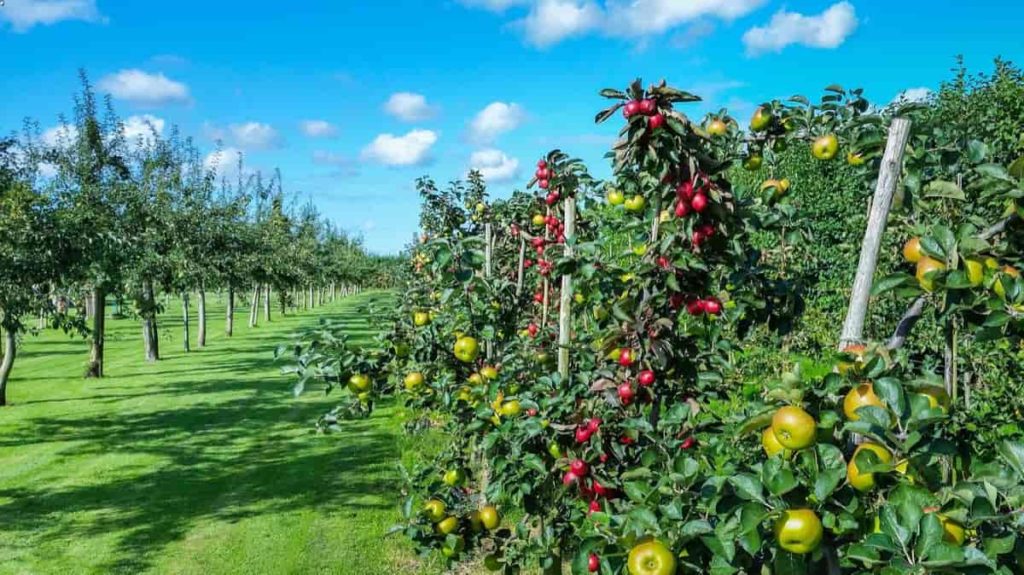
Fruit plants need good soil nutrients for good growth and fruiting. Plants suffering from severe nutritional stress are often in decline and are at higher risk for certain diseases and insects. Excessive use of chemical or organic fertilizers can burn plants and roots, stimulate leaf growth at the expense of fruit, and cause poor growth, which is susceptible to disease and sucking insects.
Nutrients importance in Apple trees
Tree nutrition is probably the essential factor for a successful gardening operation, and it can be controlled through a proper fertilization program. Nutrition is necessary for tree growth and fruit growth, and it usually needs to be converted into soil. Phosphorus is taken from the depths of the soil. Therefore, add to planting Surface applications rarely move to deep-rooted areas. Potassium is essential for good fruit size, color, and taste. In addition, it promotes winter hardiness and good tree health in general.
All healthy fruit trees are heavy feeders that remove large amounts of minerals from the soil. Although all plants need 16 essential nutrients, fruit trees pay the most attention to macronutrients. Therefore, it is necessary to change these nutrients regularly to keep trees strong. The macronutrients we should use periodically are Nitrogen, Phosphorus, Potassium, Calcium, Magnesium, and Sulfur. Carbon, hydrogen, and oxygen are also required in large quantities, but they are provided by air, water, and organic matter.
Mature Apple trees have extensive root systems. Roots that absorb water and store extra nutrients for next year’s growth can go up to about 4 feet deep, but feeder roots that absorb most nutrients are 12 inches above the soil. Therefore, fertilizers should be spread evenly over the surface, starting at a distance of at least one foot from the stem and extending beyond the drip line. Feeding deep roots with holes in the ground is only necessary with compacted soil or in areas with excessive water flow. Be careful not to re-fertilize regions that have been previously treated with other fertilizers.
Fertilizer management for Apple trees
Best time to fertilize an Apple tree
The time for fertilizer application in the Apple tree falls after the leaves have fallen. Therefore, it is an excellent time to fertilize fruit trees in late winter or early spring. Whatever form or type of fertilizer you choose, the earliest application should be at the time of bud formation in early spring.
In case you missed it: High-Density Apple Farming – Planting, Spacing, Yield In India.
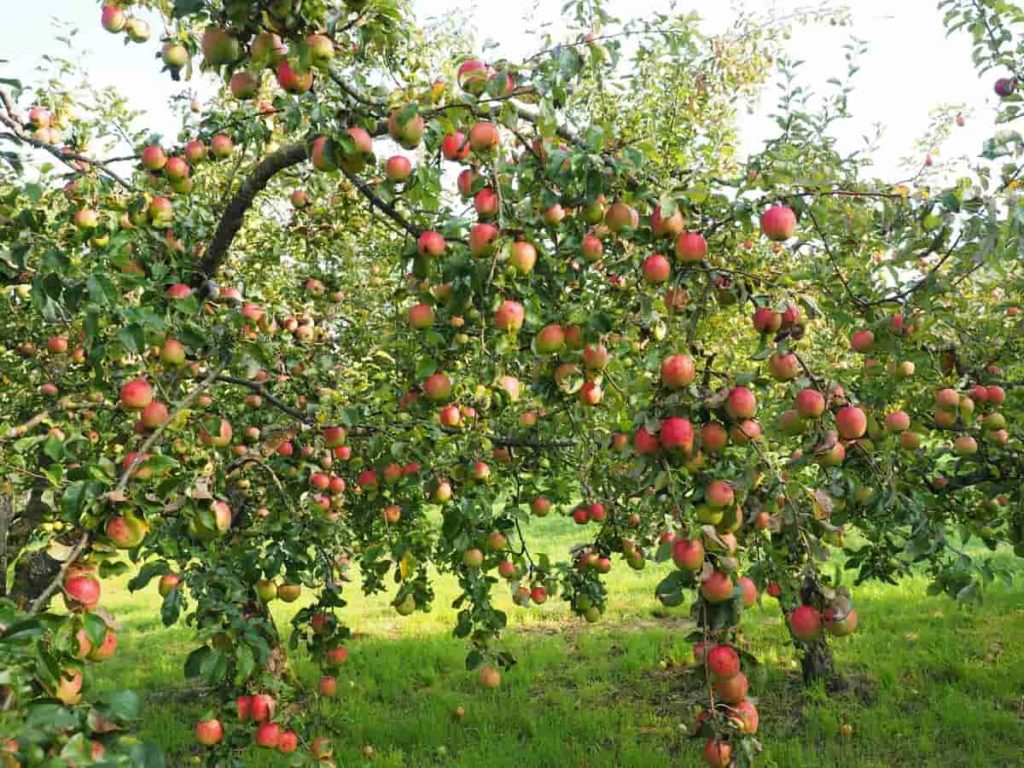
The second application should be made at the end of the spring after the fruit set. If the tree is young or has not borne fruit for some other reason, the second application may be dropped. Mid-summer is the latest time to apply fertilizer. After that, weak growth is susceptible to winter damage or disease.
NPK fertilizers
For a bearing tree, apply FYM 25 Kg, N 500 grams, and each kg P and K per bearing tree.
Types of fertilizers in Apple trees
Apple fertilizers can be organic or inorganic, but the nutrients are the same for your trees. Both types can be applied as spray-on soil or Apple leaves. In addition to dry forms, many liquid organic fertilizers are also available, including fish emulsions and seaweed concentrates. Compost can also be used to provide light nutrients to plants. The soil test confirms what nutrients your soil needs and suggests the amounts and shapes of nutrients that might be best. Advise your soil laboratory that you are growing Apples. They will provide specific Apple recommendations.
Some essential nutrients for Apple trees
Nitrogen
Excess nitrogen delays fruit ripening and adversely affects the Apple’s red color. It also delays flowering and can promote plant growth at the end of the season, especially in young trees, which increases the chances of freeze injury. Excessive tree vigor resulting from too much N can be partially compensated by pruning at the end of the heat. It has two main effects: it improves fruit color by improving light distribution and restricts root growth.
Recommendations for nitrogen use in Apple orchards are often confusing and vary considerably in the Apple-growing regions of the country. However, a nitrogen fertilization program can be better understood if it is based on the period of root up, the pattern of nitrogen storage in trees, and the time of the season or the physical stage of the tree. In addition, due to many factors, the grower must monitor the tree’s growth, leaf nutrients, yield, and fruit quality to make annual adjustments to the nitrogen program.
Too much nitrogen is not good – If a bit of nitrogen promotes better growth and healthier Apple trees, you may think it is better to apply too much nitrogen. However, too much nitrogen can damage your fruit trees as much as too little nitrogen. Fruit trees require a balanced diet of nitrogen, phosphorus, potassium, and various minerals to thrive.
If they already have the right amount of fertility where they are planted, adding extra nitrogen can promote excessive soft growth that can quickly deteriorate in the winter, possibly affecting the tree. Adding excess nitrogen can also lead to malnutrition which can damage the tree. Therefore, it is essential to keep the balance. On the other hand, too much nitrogen can block fruits and flowers and even damage the roots of your trees.
In case you missed it: Organic Apple Farming, Cultivation Practices
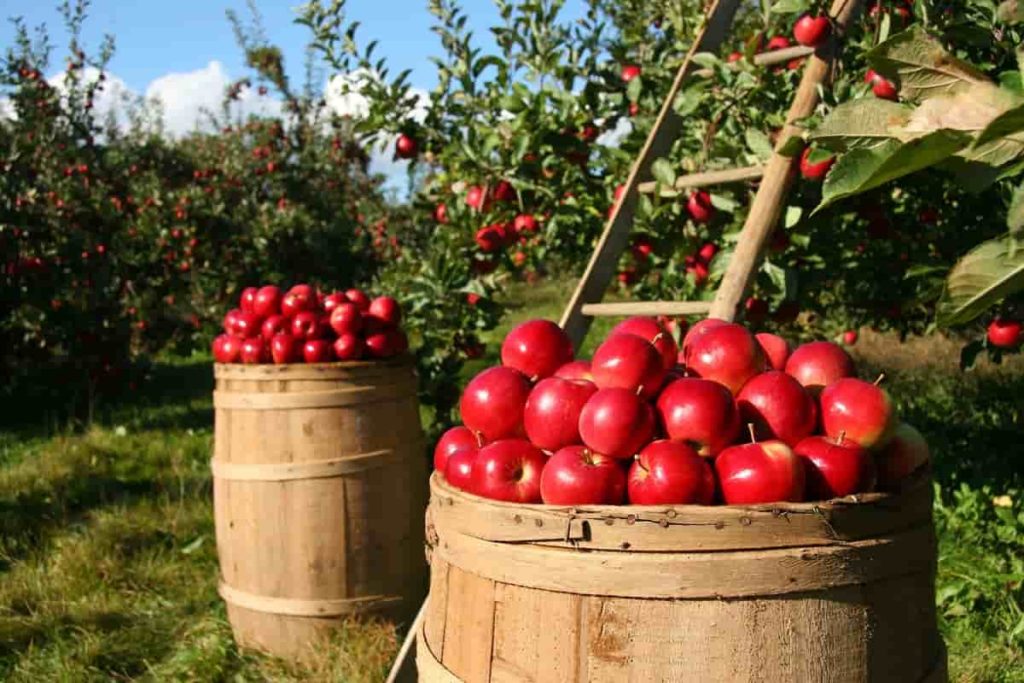
Potassium (K)
The soil releases enough potassium for the use of trees. In many cases, the perennial root system of Apple trees allows the soil to absorb enough nutrients that are scarce for annual or seed crops. Apple trees grow in sandy soils; however, they usually require potassium. Analysis of the leaves will help determine if potassium fertilizer is needed. In addition, apple trees use large amounts of potassium to produce fruit each year. Potassium improves the size and color of fruits and can help protect buds from frost damage in spring.
Phosphorus (P)
Apple trees have not responded to phosphorus fertilization regardless of soil or leaf analysis results. Therefore, phosphorus fertilizer application has not been recommended in the past. In addition, with high pH in New Like potassium, Apple trees’ extensive and perennial root system absorbs enough phosphorus in the soil to meet the tree’s needs.
Whenever there is a lack of phosphorus, it appears on the twigs, leaves, and leaves. As a result, the growth of the twigs seems thin, the petioles of the leaves are somewhat straight, the leaves may be smaller than usual, and they are dark green with the reddish or purple color of the medium and large veins.
Organic fertilizers
Apple trees mainly prefer high nitrogen fertilizer. Composted chicken manure, blood, soybean, cottonseed, and feather are excellent organic nitrogen sources. Organic fertilizers provide the Apple trees with the nutrients they need to grow healthy Apples and grow stronger over the years. Benefits of using organic fertilizers include;
- Increasing nutrient availability
- Reduced soil compaction
- Reducing the flow of pesticides
When you purchase fertilizers, you do not need products that are 100% nitrogen. Instead, choose a natural, organic fertilizer rich in nitrogen and other nutrients. The number of products sold as fertilizer indicates N-P-K rating, N – nitrogen, P – phosphorus, and K – potassium. For example, if a product is rated 9-3-0, as with fish meal, it contains 9% nitrogen, 3% phosphorus, and no potassium. Nitrogen promotes green leaf growth. Phosphorus encourages root growth and flowering. Potassium helps in fruit and seed development.
In case you missed it: Apple Tree Pests and Diseases, Control Management
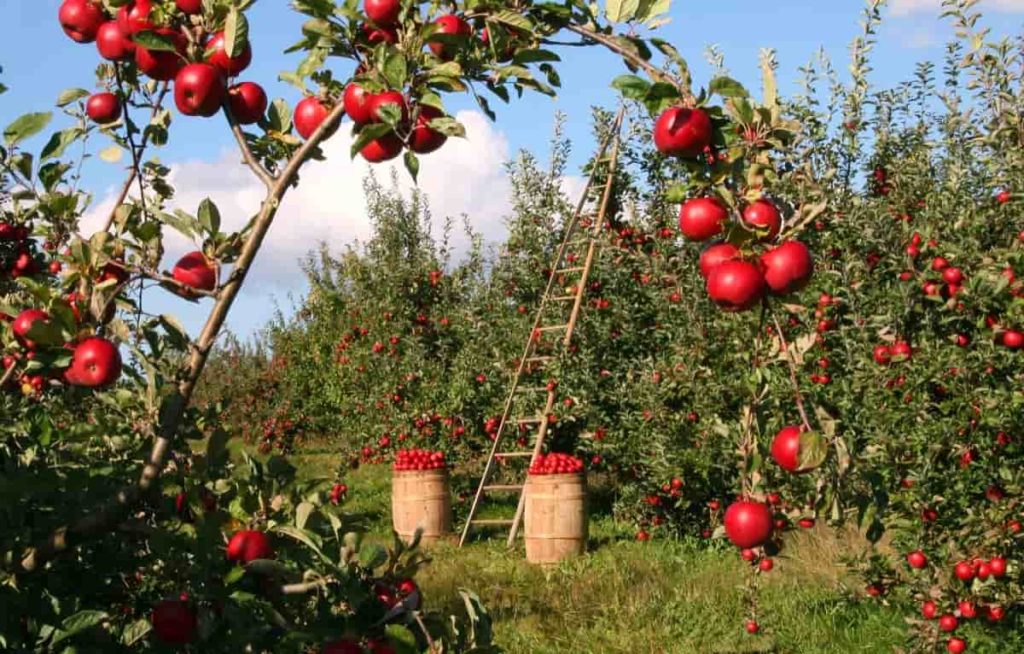
Organic vermicompost for Apple trees
It is essential to take care of your trees, which have the potential for long and fruitful life. Proper planting at the emerging stage and meeting their needs will help them thrive, but mature plants can also use gentle, loving care not to overgrow or show signs of weakness. In addition, apple trees need regular fertilizer for healthy growth.
Fertilizer application tips
Scatter dry fertilizer under the tree and apply it to the drip line, which is an imaginary circle under the growing tops of the tree. Apple trees grow best with less competition than turf or other plants. If grass or other ground cover and shrubs compete with your Apples, additional fertilizer may be needed. Liquid fertilizers prepared for watering should be used to cover this area. Keep organic and inorganic fertilizers at least 6 inches away from the tree trunk. Ready-to-use plant fertilizers can be sprayed on tree leaves. The use of foliar makes nitrogen readily available.
When to apply organic fertilizer on Apple trees
Fertilizing Apple trees should be done three times during the growing season.
- Apply first in early spring, before flowering, in mid-April in most areas in temperate areas.
- Apply the second application about a month after flowering in late May.
- And the last fertilizer application should be made at the end of June, about a month after the second application.
How to fertilize Apple trees
Nitrogen and potassium are essential for leaf growth, flower and fruit set, while phosphorus is essential for solid root system development, especially plant growth. Calcium, magnesium, manganese, zinc, and boron are crucial for bud development, flowering, and various flowering stages. Any deficiency can adversely affect the fruit tree’s number, quality, and health.
It is essential to check the nutrients and pH of the soil before applying any method of fertilization. Furthermore, suppose a complete coverage irrigation system is combined with the presence of alfalfa or other beans in a dense planting system. In that case, the need to fertilize Apple trees is drastically reduced, as the core crop usually produces organic matter. The average leaf is deficient in some nutrients; then, we can add the appropriate element.
In case you missed it: Custard Apple Seed Germination (Sugar Apple/Sitaphal)
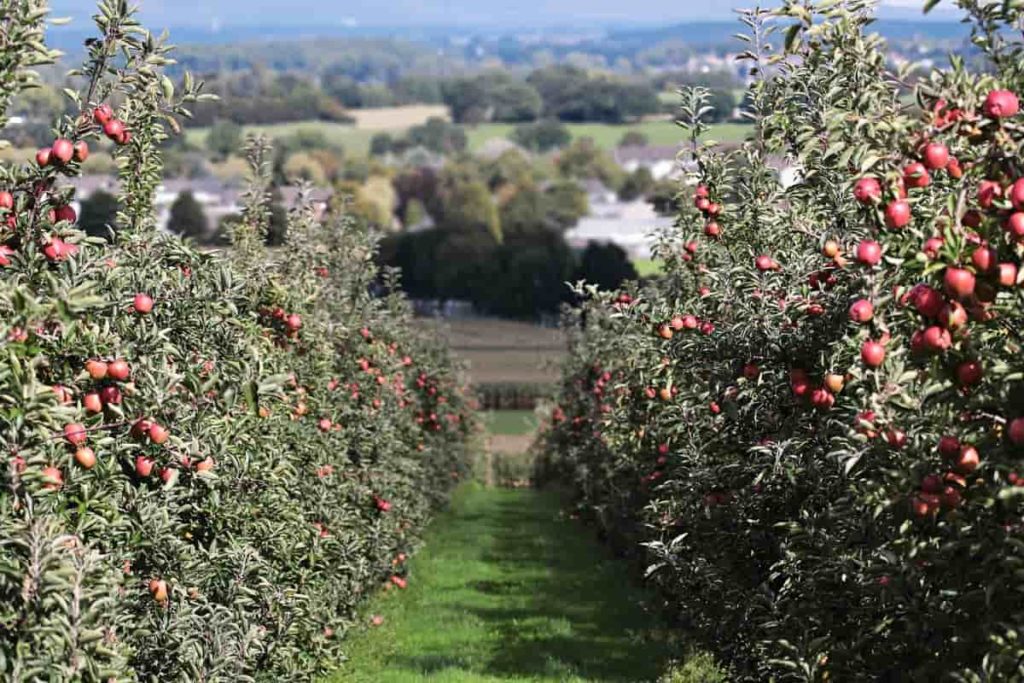
Apple’s nutritional requirements for different growth stages
Apple’s nutritional requirements vary depending on the stage of the crop’s development. Find out which nutrients are most important to varying stages of development.
Bud burst – beginning of flowering
- Nitrogen, potassium, and magnesium – Promote strong early growth of new plant tissues and maximize tree productivity
- Phosphorus – Maximizes root growth and flower clusters
- Calcium – Promotes root and leaf growth and high yields
- Boron – Maximum pollen and strong flower growth
- Manganese – To maximize tissue growth
- Zinc – To improve budburst and early leaf growth
Fruit set – Fruitlet
- Nitrogen – Maintain fruit filling in small amounts
- Potassium – Minimizes fruit breakdown
- Phosphorus – Fruit set and growth
- Calcium – Maintains good fruit quality and reduces fruit diseases
- Magnesium – For reduced fruit drop
- Boron – Improve fruit set
Fruit Fill – Maturity
- Nitrogen – In reduced amounts to maintain Fruit filling and keep high sugars
- Potassium – Increases fruit weight and minimizes disorders
- Calcium – Maintain fruit strength and storage quality
- Manganese – Phosphorus will promote fruit color
Post-harvest
- Nitrogen and Potassium – Increase reserves for early growth next season
- Phosphorus – Maximize bud growth and early root and new tissue growth next spring
- Calcium – Maintain high levels in trees
- Magnesium, boron, and zinc – Strengthen new buds
In case you missed it: Apple Fruit Drop Causes, Factors, and Control Methods
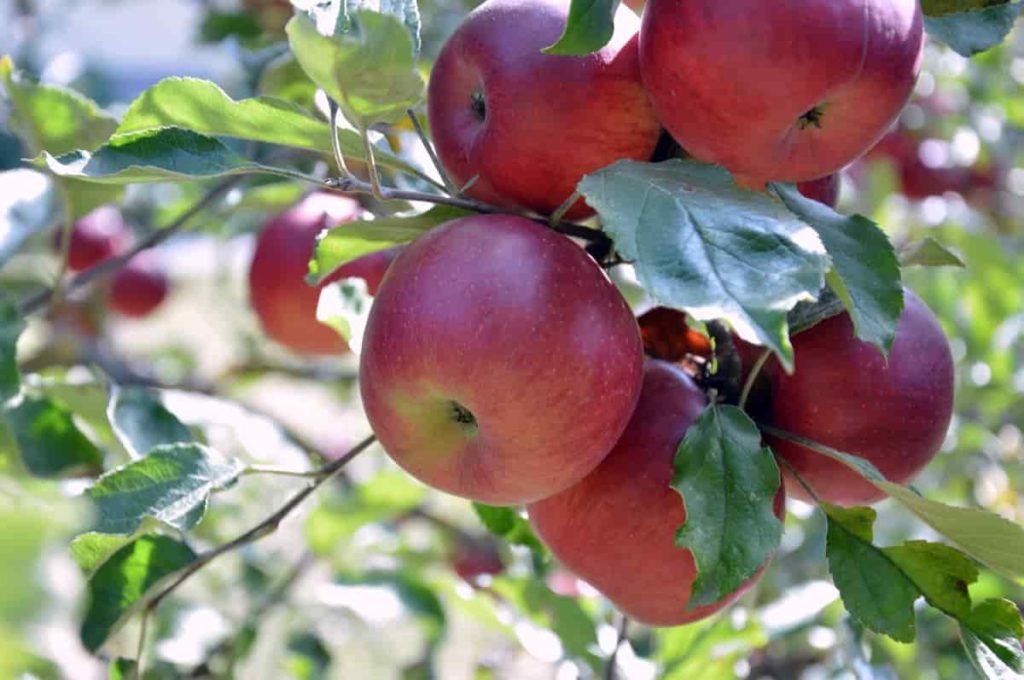
Frequently asked questions about fertilizers for Apple trees (FAQ)
Is urea suitable for Apple trees?
It is common for Apple trees to be sprayed with 0.5% urea solution in the early post-flowering period, which, when repeated several times, has a marked increase in leaf chlorophyll and leaf total nitrogen compared to non-sprayed tree leaves. However, too much concentration can cause leaf injury.
Do Apple trees need potassium?
Apple trees use large amounts of potassium to produce fruit every year. Potassium improves the size and color of fruits and can help protect buds from frost damage in spring.
How can I grow my Apple tree faster?
Increase the use of fertilizer as the tree ages to promote sustainable growth. For example, in the second year of the fruit tree, apply one pound of 21-0-0 fertilizer. Use 1.5 pounds of the same fertilizer in the third year. Then add one pound of fertilizer each year.
- How to Make Houseplants Bushy: Effective Tips and Ideas
- Innovative Strategies for Boosting Coconut Pollination and Yield
- Pollination Strategies for Maximum Pumpkin Yield
- The Complete Guide to Chicken Fattening: Strategies for Maximum Growth
- Natural Solutions for Tulip Problems: 100% Effective Remedies for Leaf and Bulb-Related Issues
- Revolutionizing Citrus Preservation: Towards a Healthier, Greener Future
- Natural Solutions for Peony Leaf and Flower Problems: 100% Effective Remedies
- Maximizing Profits with Avocado Contract Farming in India: A Comprehensive Guide
- Natural Solutions for Hydrangea Problems: 100% Effective Remedies for Leaf and Flowers
- The Ultimate Guide to Choosing the Perfect Foliage Friend: Bringing Life Indoors
- From Sunlight to Sustainability: 15 Ways to Use Solar Technology in Agriculture
- The Ultimate Guide to Dong Tao Chicken: Exploring from History to Raising
- The Eco-Friendly Makeover: How to Convert Your Unused Swimming Pool into a Fish Pond
- Mastering the Art of Delaware Chicken Farming: Essentials for Healthy Backyard Flocks
- 20 Best Homemade Fertilizers for Money Plant: DIY Recipes and Application Methods
- How to Craft a Comprehensive Free-Range Chicken Farming Business Plan
- Brighten Your Flock: Raising Easter Egger Chickens for Beauty and Bounty
- How to Optimize Your Poultry Egg Farm Business Plan with These Strategies
- Subsidy for Spirulina Cultivation: How Indian Government Schemes Encouraging Spirulina Farmers
- Ultimate Guide to Raising Dominique Chickens: Breeding, Feeding, Egg-Production, and Care
- Mastering the Art of Raising Jersey Giant Chickens: Care, Feeding, and More
- Ultimate Guide to Raising Legbar Chickens: Breeding, Farming Practices, Diet, Egg-Production
- How to Raise Welsummer Chickens: A Comprehensive Guide for Beginners
- How to Protect Indoor Plants in Winter: A Comprehensive Guide
- Ultimate Guide to Grow Bag Gardening: Tips, Tricks, and Planting Ideas for Urban Gardeners
- Guide to Lotus Cultivation: How to Propagate, Plant, Grow, Care, Cost, and Profit
- Agriculture Drone Subsidy Scheme: Government Kisan Subsidy, License, and How to Apply Online
- Ultimate Guide to Raising Araucana Chickens: Breed Profile, Farming Economics, Diet, and Care
- Bringing Hydroponics to Classroom: Importance, Benefits of Learning for School Students
- Ultimate Guide to Raising Polish Chickens: Breed Profile, Farming Economics, Diet, and Care
- Ultimate Guide to Raising Australorp Chickens: Profile, Farming Economics, Egg Production, Diet, and Care
- Silkie Chicken Farming: Raising Practices, Varieties, Egg Production, Diet, and Care
- Sussex Chicken Farming: Raising Practices, Varieties, Egg Production, Diet and Care
- Homemade Feed Formulations for Livestock: Discover Cost-effective Starter to Finisher Feed Recipes
- 20 Best Pig Weight Gain Supplements: Top Swine Weight Gain Formulas
- Ultimate Guide to Elderberry Farming: Propagation, Planting, Yield, Cost, and Profit